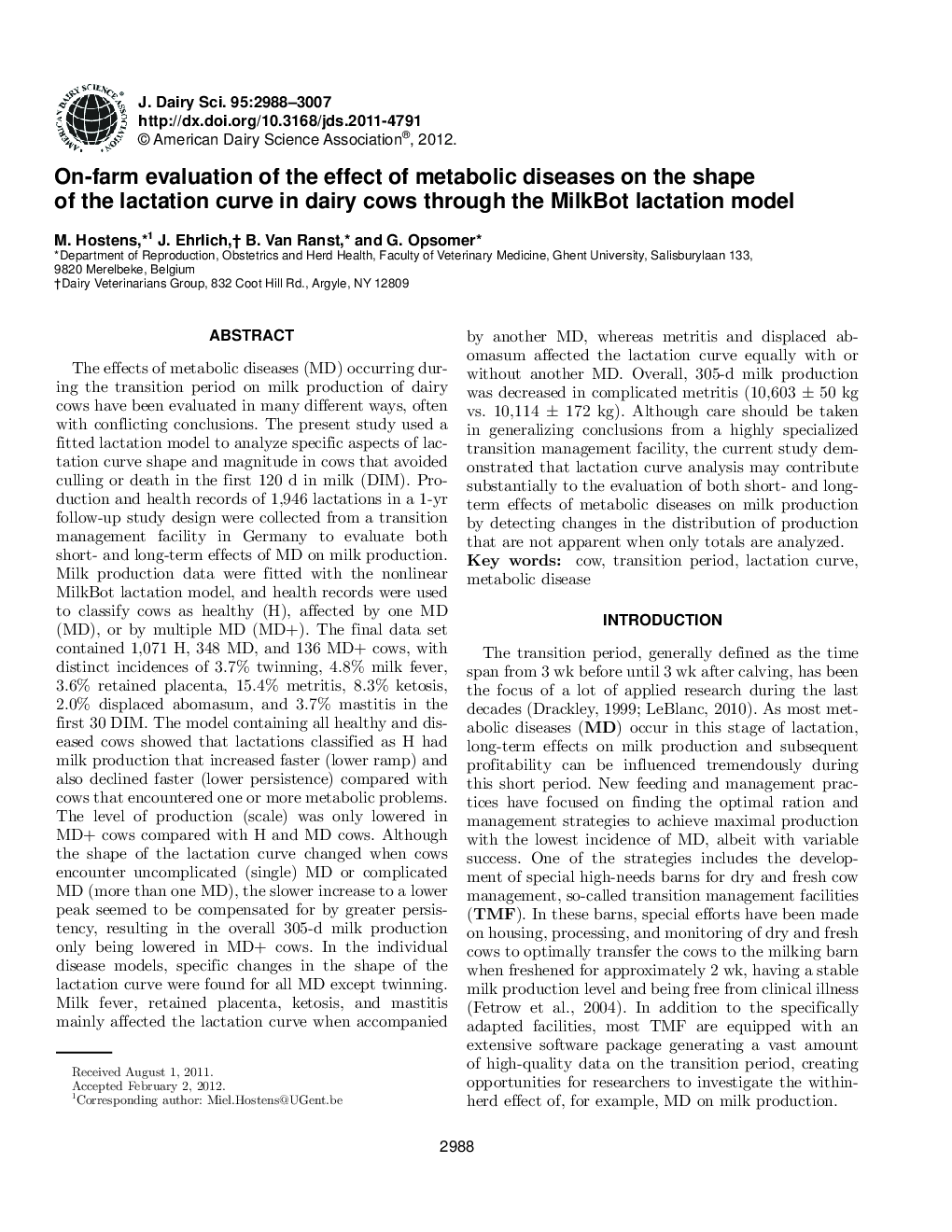| کد مقاله | کد نشریه | سال انتشار | مقاله انگلیسی | نسخه تمام متن |
|---|---|---|---|---|
| 10975627 | 1108035 | 2012 | 20 صفحه PDF | دانلود رایگان |
عنوان انگلیسی مقاله ISI
On-farm evaluation of the effect of metabolic diseases on the shape of the lactation curve in dairy cows through the MilkBot lactation model
دانلود مقاله + سفارش ترجمه
دانلود مقاله ISI انگلیسی
رایگان برای ایرانیان
کلمات کلیدی
موضوعات مرتبط
علوم زیستی و بیوفناوری
علوم کشاورزی و بیولوژیک
علوم دامی و جانورشناسی
پیش نمایش صفحه اول مقاله

چکیده انگلیسی
The effects of metabolic diseases (MD) occurring during the transition period on milk production of dairy cows have been evaluated in many different ways, often with conflicting conclusions. The present study used a fitted lactation model to analyze specific aspects of lactation curve shape and magnitude in cows that avoided culling or death in the first 120 d in milk (DIM). Production and health records of 1,946 lactations in a 1-yr follow-up study design were collected from a transition management facility in Germany to evaluate both short- and long-term effects of MD on milk production. Milk production data were fitted with the nonlinear MilkBot lactation model, and health records were used to classify cows as healthy (H), affected by one MD (MD), or by multiple MD (MD+). The final data set contained 1,071 H, 348 MD, and 136 MD+ cows, with distinct incidences of 3.7% twinning, 4.8% milk fever, 3.6% retained placenta, 15.4% metritis, 8.3% ketosis, 2.0% displaced abomasum, and 3.7% mastitis in the first 30 DIM. The model containing all healthy and diseased cows showed that lactations classified as H had milk production that increased faster (lower ramp) and also declined faster (lower persistence) compared with cows that encountered one or more metabolic problems. The level of production (scale) was only lowered in MD+ cows compared with H and MD cows. Although the shape of the lactation curve changed when cows encounter uncomplicated (single) MD or complicated MD (more than one MD), the slower increase to a lower peak seemed to be compensated for by greater persistency, resulting in the overall 305-d milk production only being lowered in MD+ cows. In the individual disease models, specific changes in the shape of the lactation curve were found for all MD except twinning. Milk fever, retained placenta, ketosis, and mastitis mainly affected the lactation curve when accompanied by another MD, whereas metritis and displaced abomasum affected the lactation curve equally with or without another MD. Overall, 305-d milk production was decreased in complicated metritis (10,603 ± 50 kg vs. 10,114 ± 172 kg). Although care should be taken in generalizing conclusions from a highly specialized transition management facility, the current study demonstrated that lactation curve analysis may contribute substantially to the evaluation of both short- and long-term effects of metabolic diseases on milk production by detecting changes in the distribution of production that are not apparent when only totals are analyzed.
ناشر
Database: Elsevier - ScienceDirect (ساینس دایرکت)
Journal: Journal of Dairy Science - Volume 95, Issue 6, June 2012, Pages 2988-3007
Journal: Journal of Dairy Science - Volume 95, Issue 6, June 2012, Pages 2988-3007
نویسندگان
M. Hostens, J. Ehrlich, B. Van Ranst, G. Opsomer,